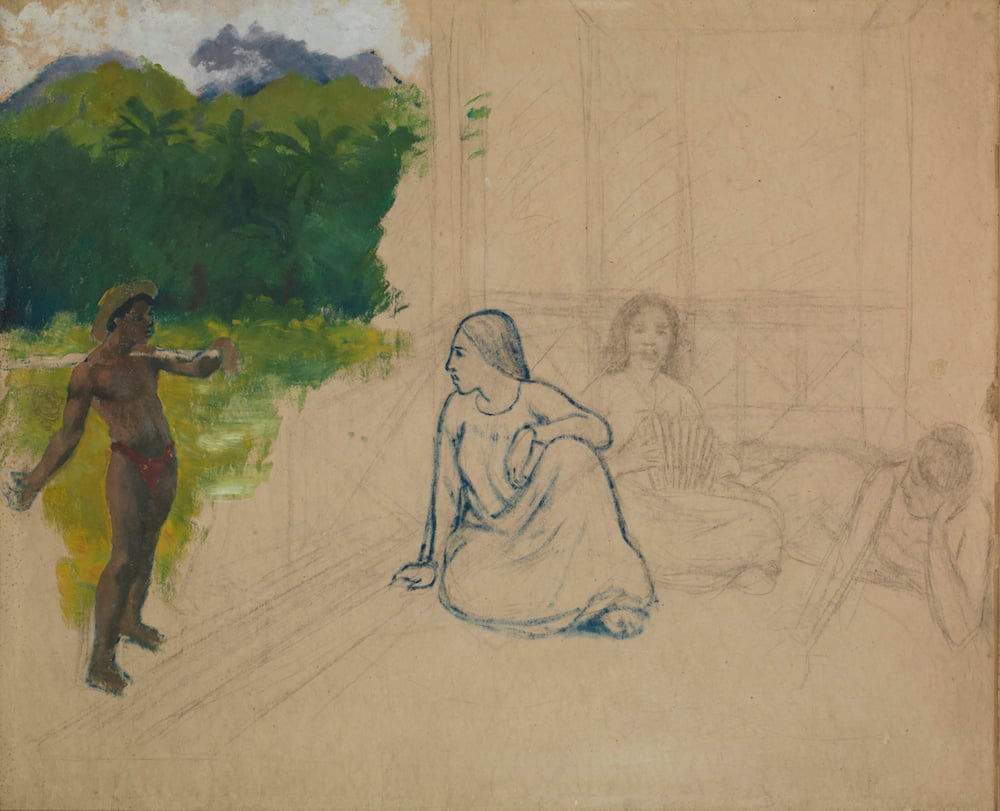
An unfinished work in the collection of the Tate in London, long believed to be by the famous Post-Impressionist artist Paul Gauguin, just got a major downgrade. Tahitians, circa 1891, has been excluded from the most recent catalogue raisonné published this past spring by the Wildenstein Plattner Institute (WPI). The news was first reported by The Art Newspaper.
Asked for comment, the Tate provided a statement to Artnet News, saying: “The unfinished work on paper Tahitiens, c.1891, was included by Roger Fry in the exhibition ‘Manet and the Post-Impressionists’ at the Grafton Galleries in 1910. Following the exhibition Fry arranged for it to be presented to Tate by the Contemporary Art Society in 1917. The work was included by the Wildenstein Institute in the first edition of their Gauguin catalogue raisonné in 1964, and Tate was not contacted prior to the publication of their latest edition.”
The museum further acknowledged, “We recognize there has been ongoing research into Gauguin’s work in recent years, so we will keep the work under review and retain an open mind about any research that might help cast familiar works in a new light.”
The Wildenstein Plattner Institute, a nonprofit that is also involved in publishing catalogues raisonné for Jasper Johns, Romare Bearden, and Tom Wesselman, does not reveal its methodology or details around authentications. The foundation did not immediately respond to Artnet News’s request for comment.
According to TAN, the absence of the work from the most recent catalogue was flagged by Fabrice Fourmanoir, a Gauguin fan turned researcher who formerly lived in Polynesia.
The decision to exclude the work, which is not signed, from the catalogue was reportedly made by two head committee members, Richard Brettell, who passed away in July 2020, and Sylvie Crussard, with whom Brettell worked for two decades. The Wildenstein Plattner Institute is withholding the reasons for the rejection to “maintain the confidentiality” of its discussions around making decisions. According to its website, an additional installment to the Gauguin digital catalogue raisonné, with text by Crussard, is forthcoming.
Tahitians is considered an unusual work because the left side, which depicts a shirtless boy, is rendered in oil, while three woman in the center-right portion are drawn in charcoal, and the woman in the center is more fully delineated with an extra outline of blue crayon.
The Galerie Druet in Paris is the first recorded owner of Tahitians, according to TAN. A few months after Druet loaned the work to Fry—an art historian who is credited with inventing the term “Post-Impressionism”—for a show, Fry purchased it for about £30, believing it was an authentic Gauguin.
The work had been considered genuine ever since it was presented to the Tate in 1917, when it was then known as the National Gallery Millbank. In 2010 it was included in the exhibition “Gauguin: Maker of Myth” at Tate Modern, though it was not included when the show traveled to the National Gallery of Art in Washington, D.C.
Fourmanoir, whose research last year led the J. Paul Getty Museum to walk back the attribution on a statuette it acquired as a Gauguin, is convinced that the work is a fake. “It is a stereotypical colonial Tahiti scene, whereas Gauguin was looking for more primitive compositions. The poses, dresses and even the European accordion held by the woman show Tahitians ‘corrupted’ by European customs,” he told TAN.